OME2 unlocks pan-European high-value data and calls for EU commitment to long-term funding
Open Maps For Europe 2 (OME2) has unlocked one of Europe's most valuable assets by turning EU rules for high-value data into a seamless cross-border solution for governments, businesses, and citizens.
The OME2 pan-European prototype harmonises and edge-matches official geospatial data from national mapping, land registration and cadastral agencies into a single dataset. This fulfils a long-standing EU requirement for streamlined access to authoritative cross-border information without navigating multiple national portals or complex data integration.
The final version – unveiled at a showcase for policymakers in Brussels – provides 1: 10 000 scale authoritative administrative boundary, transport and hydrographic data for Austria, Belgium, Czech Republic, Denmark, Finland, France, Luxembourg, Spain, Switzerland and The Netherlands.
OME2 is being delivered by a consortium comprising: EuroGeographics, the not-for-profit association representing the European National Mapping, Cadastral and Land Registration Authorities; National Geographic Institute, Belgium; National Institute of Geographic and Forest Information, France (IGN France); Hellenic Cadastre; General Directorate for the Cadastre, Spain; and Cadastre, Land Registry and Mapping Agency (Kadaster), The Netherlands.

Sallie Payne Snell, Secretary General and Executive Director, EuroGeographics addresses EU polcymakers at OME2 showcase.
“This proves that EuroGeographics and its members can deliver large-scale edge-matched data that users want – laying the foundation for a broader pan-European Spatial Data Infrastructure.”
She added: "OME2 concludes at the end of 2025 and is co-funded by the European Union with matched investment from EuroGeographics and its members. However, securing long-term funding for Europe-wide sovereign high-value data remains a challenge.”
"A self-funded consortium, bringing together EuroGeographics and its members from Germany's Federal Agency for Cartography and Geodesy (BKG), IGN France, and Kadaster Netherlands, has stepped forward to take the outcomes of OME2 to the next level. Together, we are committed to providing the expertise and initial investment for this exciting new project, which will be publicly launched in early 2026 and run until 2028.”
"If Europe is to continue benefiting from comprehensive cross-border sovereign high-value data after this date, the European Commission must commit to sustainable funding, ongoing infrastructure investment, and a policy home for geospatial data. Trusted pan-European geospatial data is recognised as one of Europe's most valuable resources – it deserves recognition and sustained investment at the European level."
EuroGeographics is an international not-for-profit organisation (AISBL/ IVZW under Belgian Law. BCE registration: 833 607 112) and the membership association for the European National Mapping, Cadastral and Land Registry Authorities.
OME2 is developing a new production process and technical specification for free-to-use, edge-matched data under a single open licence. Authoritative 1:10 000 scale data for 10 countries will be delivered via the user interface built by the award-winning Open Maps For Europe Project. OME2 is also enhancing the five existing Open Maps For Europe datasets, including the pilot Open Cadastral Map.
The OME2 project is co-funded by the European Union. It is being delivered by a consortium comprising: EuroGeographics, the not-for-profit membership association for Europe’s National Mapping, Cadastral and Land Registration Authorities; National Geographic Institute, Belgium; National Institute of Geographic and Forest Information, France; Hellenic Cadastre; General Directorate for the Cadastre, Spain; and Cadastre, Land Registry and Mapping Agency, The Netherlands.
Views and opinions expressed are however those of the author only and do not necessarily reflect those of the European Union or European Commission. Neither the European Union nor the European Commission can be held responsible for them.


 Five new countries have been added to the final release of the Open Cadastral Map which has been enhanced by the Open Maps For Europe 2 (OME2) project.
Five new countries have been added to the final release of the Open Cadastral Map which has been enhanced by the Open Maps For Europe 2 (OME2) project.


